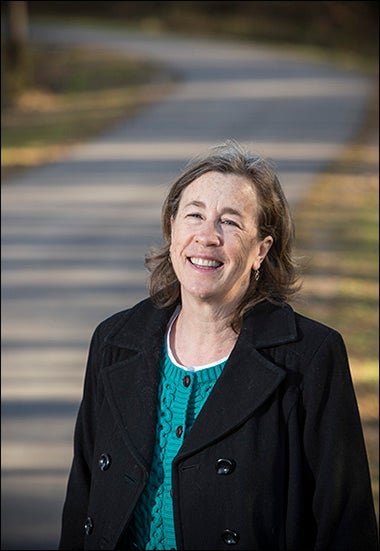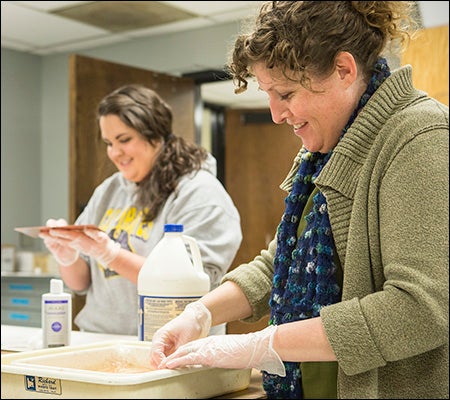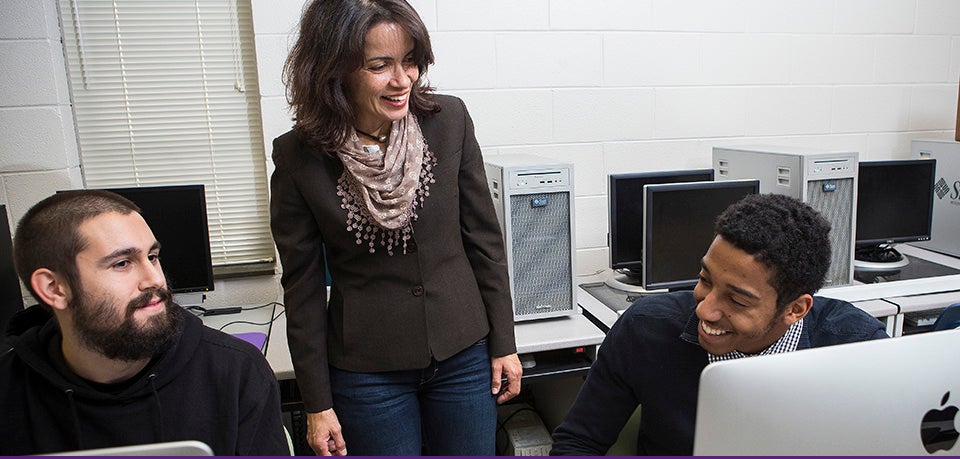SUPPORTING FELLOW TEACHERS
ECU Faculty Senate rewards innovation in the classroom
East Carolina University faculty who can generate creative, innovative ways of teaching course materials are eligible for grants offered by Teaching Grants Committee of ECU’s Faculty Senate.
“The grants are for people who have a new approach…some kind of innovative or creative idea,” said Donna Roberson, associate professor of nursing and chair of the Teaching Grants Committee. Ideas submitted for consideration “should address different ways of…bringing the topic alive for the students,” she said.

ECU biology professor Carol Goodwillie used funding from the Faculty Senate grants to establish a service-learning science course.
The grants program is just one of the ways ECU’s Faculty Senate, which represents faculty in the shared governance between faculty and administration, has supported fellow teachers for 50 years. The senate will celebrate its 50th anniversary during its March 17 meeting.
Biology associate professor Carol Goodwillie received funds from the faculty senate’s Teaching Grants Committee – making the first service learning science course at ECU possible.
Thirty of Goodwillie’s students helped remove invasive plants in an ongoing habitat restoration project at River Park North, led by Christopher Horrigan of the Greenville Recreation and Parks Department. They also removed more than 3,000 stems of Chinese lespedeza, another invasive plant, on the South Tar Greenway.
Incorporating material on invasive plants into her lectures, Goodwillie asked students to consider what physiological and reproductive aspects of plants make them invasive.
“I hope to encourage other STEM faculty to explore this approach with other kinds of student service projects,” she said.
Associate professor Rosana Ferreira from the Department of Geography, Planning and Environment used her teaching grant to develop a virtual weather forecasting teaching laboratory.
The new laboratory gives students a better understanding of weather phenomena through hands-on simulations and has provided Ferreira a formal way of introducing students to the numerical weather forecasting model.
“Numerical models are the most important tools in modern weather forecasting,” said Ferreira. “This innovative virtual lab represents a very significant enhancement of current weather forecasting teaching in ECU’s new applied atmospheric science degree.”
This semester, Ferreira said hers students will “look under the hood” of the weather research and forecasting model to understand how it is built and then apply it to real weather forecasts.
“The weather research and forecasting model predicts winds, pressure, clouds, rain, temperature and many other variables,” said Ferreira. “Now that the model is here and running, all the pieces are in place to start widening the community of users at ECU.”
Still another faculty senate success story involved photography professor Angela Wells, who received a teaching grant to bring an alternative printmaking technique called “copper plate photogravure” to her students.
“Copper plate photogravure is an incredible process,” said Wells. “It is one of three historical photomechanical processes that renders a continuous tone photographic image.”

Photography professor Angela Wells, right, incorporated an alternative printmaking technique into her class, thanks to a grant from the Faculty Senate.
“Very few institutions teach the process, and being able to teach this technique sets ECU photography apart from most programs in the country,” said Wells, who has worked with the method for more than 10 years. “The process is incredibly complicated, expensive, time consuming, and oftentimes unforgiving of mistakes or human error.”
If done well, the final result renders a brilliant black and white photograph with shadow detail and depth that Wells said no other process can deliver.
“The teaching grant allowed for the purchase of the missing materials and equipment and gave me time to investigate how the materials work within our environment and studios,” she said. “I am incredibly grateful for it. The students are learning so much about their creative process and work ethic and it’s been a wonderful experience.”
The Teaching Grants Committee selects projects based on creativity, impact and sustainability. The awards are not for conventional teaching methods. “You can’t just update the reading list for your class – that’s not creative,” said Roberson.
The grants are funded by an unused faculty salary line, and awards vary in amount based on the proposal request.
For more information about the Teaching Grants Committee or to apply for a teaching grant, visit www.ecu.edu/cs-acad/fsonline/tg/teachinggrants.cfm.
